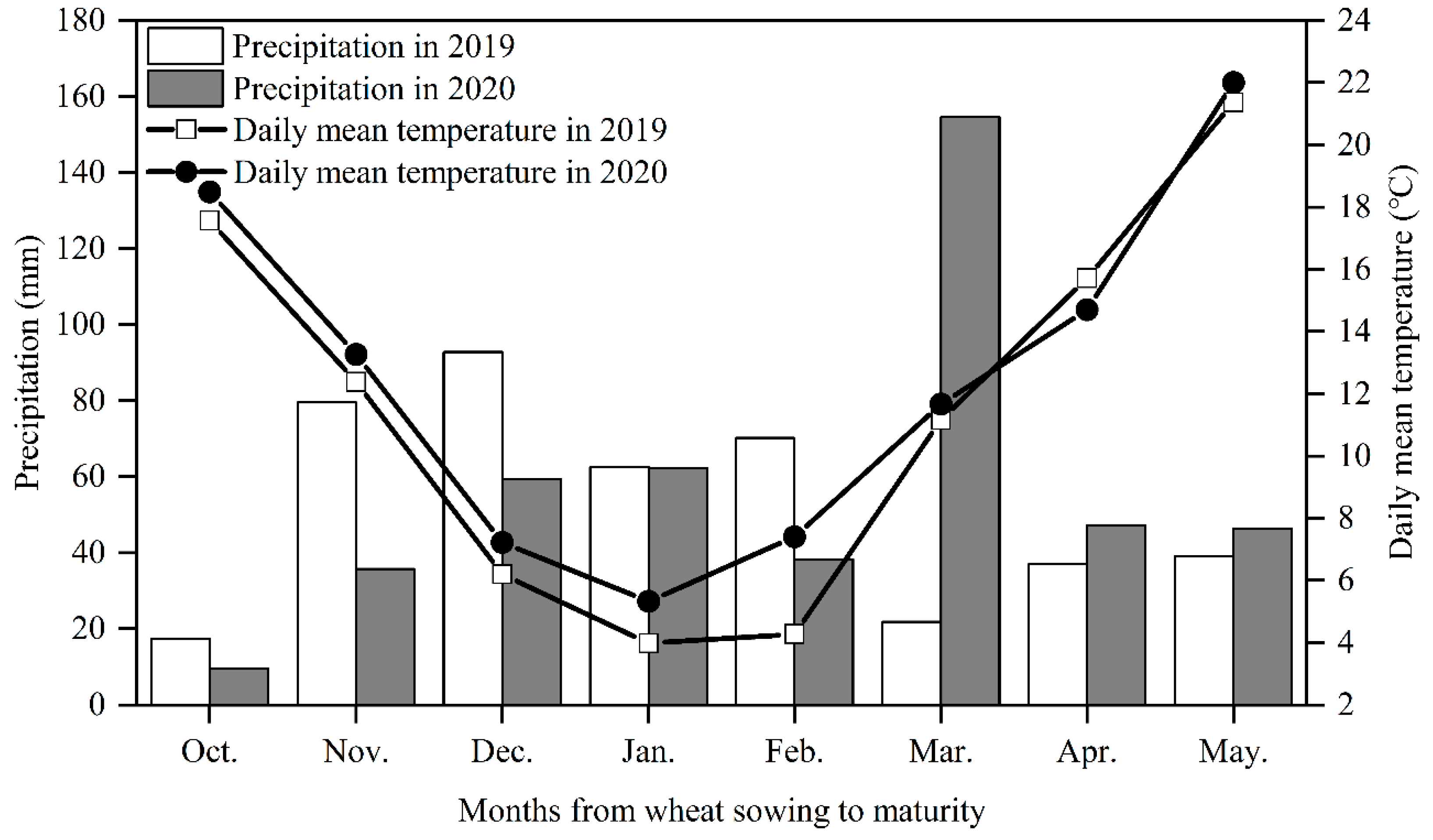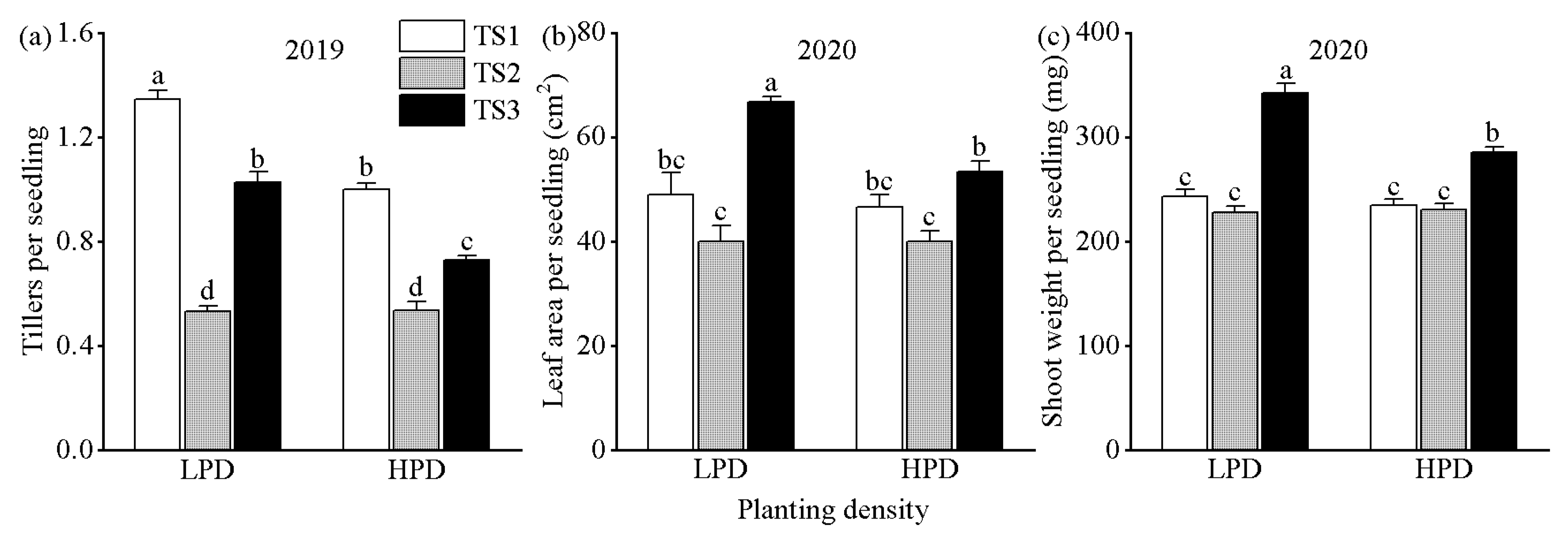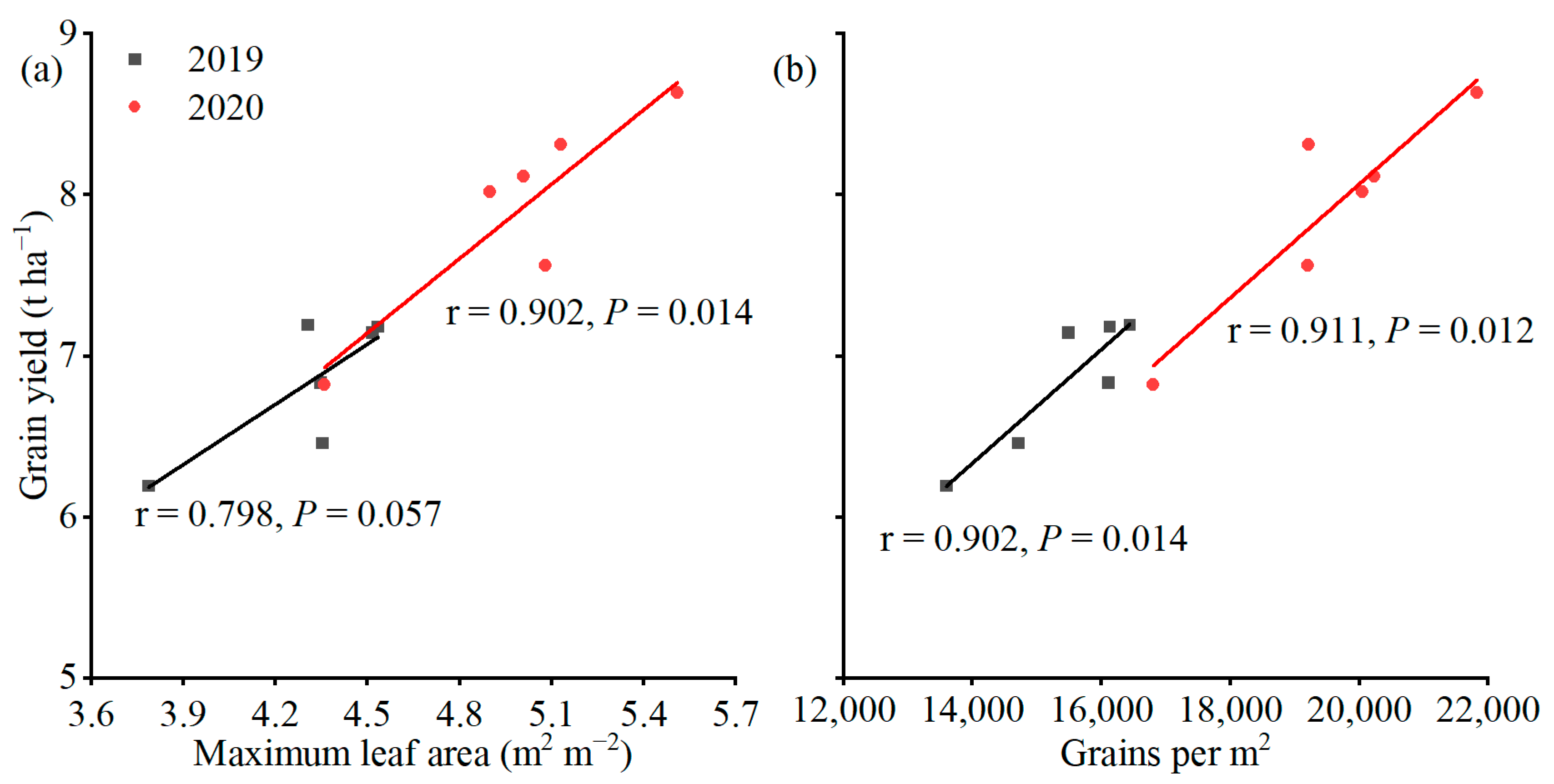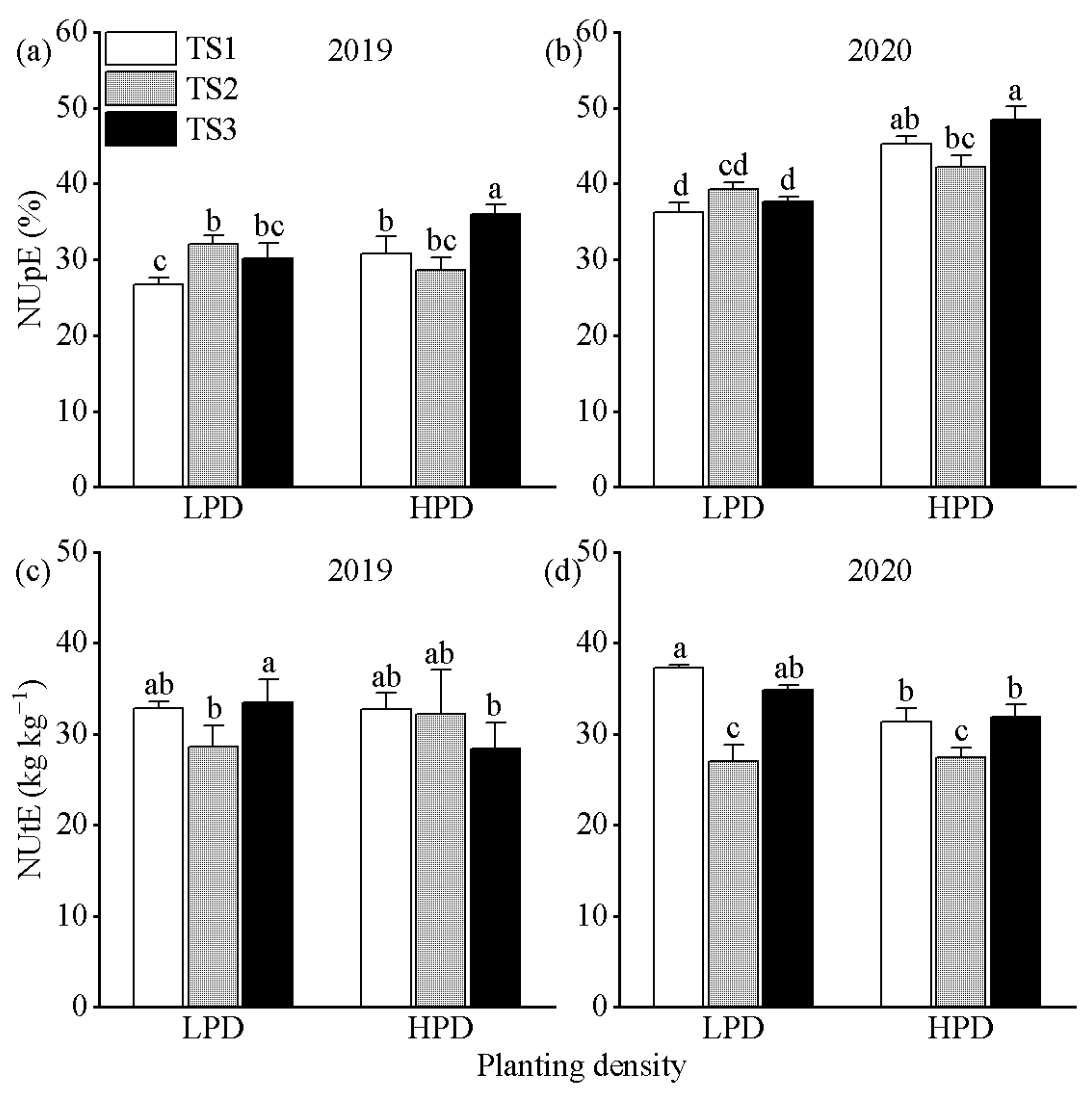Strip Tillage Improves Grain Yield and Nitrogen Efficiency in Wheat under a Rice–Wheat System in China
Abstract
1. Introduction
2. Materials and Methods
2.1. Experimental Site Description
2.2. Experimental Design
2.3. Sampling and Measurements
2.3.1. Seedling Growth
2.3.2. Grain Yield and Its Components
2.3.3. Maximum Leaf Area and Sink–Source Ratio
2.3.4. N Accumulation and Use Efficiency
2.3.5. Soil N Residue
2.4. Statistical Analysis
3. Results
3.1. Seedling Growth
3.2. Grain Yield and Its Components
3.3. Source and Sink Performances
3.4. Relationships of Seedling Growth with Source and Sink Performances
3.5. Relationships of Source and Sink Performances with Grain Yield
3.6. N Accumulation
3.7. N-Use Efficiency
3.8. Soil N Residue
4. Discussion
4.1. Increased Planting Density Enhances Grain Yield and N-Use Efficiency
4.2. Strip Tillage Promotes Seedlings Growth, Source and Sink Levels, and Grain Yield
4.3. Strip Tillage Improves Grain N Accumulation, N-Use Efficiency, and Soil N Residue
5. Conclusions
Supplementary Materials
Author Contributions
Funding
Data Availability Statement
Conflicts of Interest
References
- Gangwar, K.S.; Singh, K.K.; Sharma, S.K.; Tomar, O.K. Alternative tillage and crop residue management in wheat after rice in sandy loam soils of Indo-Gangetic plains. Soil Tillage Res. 2005, 88, 242–252. [Google Scholar] [CrossRef]
- Gozubuyuk, Z.; Sahin, U.; Adiguzel, M.C.; Ozturk, I.; Celik, A. The influence of different tillage practices on water content of soil and crop yield in vetch-winter wheat rotation compared to fallow-winter wheat rotation in a high altitude and cool climate. Agric. Water Manag. 2015, 160, 84–97. [Google Scholar] [CrossRef]
- Qiang, X.; Sun, J.; Ning, H. Impact of subsoiling on cultivated horizon construction and grain yield of winter wheat in the north China plain. Agriculture 2022, 12, 236. [Google Scholar] [CrossRef]
- Ding, J.; Li, F.; Le, T.; Xu, D.; Zhu, M.; Li, C.; Zhu, X.; Guo, W. Tillage and seeding strategies for wheat optimizing production in harvested rice fields with high soil moisture. Sci. Rep. 2021, 11, 119. [Google Scholar] [CrossRef] [PubMed]
- Singh, G.; Jalota, S.K.; Sidhu, B.S. Soil physical and hydraulic properties in a rice-wheat cropping system in India: Effects of rice-straw management. Soil Use Manag. 2005, 21, 17–21. [Google Scholar] [CrossRef]
- Sharma, P.; Tripathi, R.P.; Singh, S. Tillage effects on soil physical properties and performance of rice-wheat-cropping system under shallow water table conditions of Tarai, northern India. Eur. J. Agron. 2005, 23, 327–335. [Google Scholar] [CrossRef]
- Pagnani, G.; Galieni, A.; Egidio, S.D.; Visioli, G.; Stagnari, F.; Pisante, M. Effect of soil tillage and crop sequence on grain yield and quality of durum wheat in Mediterranean areas. Agronomy 2019, 9, 488. [Google Scholar] [CrossRef]
- He, J.; Shi, Y.; Zhao, J.; Yu, Z. Strip rotary tillage with subsoiling increases winter wheat yield by alleviating leaf senescence and increasing grain filling. Crop J. 2020, 8, 327–340. [Google Scholar] [CrossRef]
- Ding, J.; Li, F.; Xu, D.; Wu, P.; Zhu, M.; Li, C.; Zhu, X.; Chen, Y.; Guo, W. Tillage and nitrogen managements increased wheat yield through promoting vigor growth and production of tillers. Agron. J. 2021, 113, 1640–1652. [Google Scholar] [CrossRef]
- Mitchell, J.P.; Shrestha, A.; Mathesius, K.; Scow, K.M.; Southard, R.J.; Haney, R.L.; Schmidt, R.; Munk, D.S.; Horwath, W.R. Cover cropping and no-tillage improve soil health in an arid irrigated cropping system in California’s San Joaquin valley, USA. Soil Tillage Res. 2017, 165, 325–335. [Google Scholar] [CrossRef]
- Bhatt, R.; Khera, K.L. Effect of tillage and mode of straw mulch application on soil erosion in the submontaneous tract of Punjab, India. Soil Tillage Res. 2005, 88, 107–115. [Google Scholar] [CrossRef]
- Shao, Y.; Xie, Y.; Wang, C.; Yue, J.; Yao, Y.; Li, X.; Liu, W.; Zhu, Y.; Guo, T. Effects of different soil conservation tillage approaches on soil nutrients, water use and wheat-maize yield in rainfed dry-land regions of north China. Eur. J. Agron. 2016, 81, 37–45. [Google Scholar] [CrossRef]
- Mosaddeghi, M.R.; Mahboubi, A.A.; Safadoust, A. Short-term effects of tillage and manure on some soil physical properties and wheat root growth in a sandy loam soil in western Iran. Soil Tillage Res. 2008, 104, 173–179. [Google Scholar] [CrossRef]
- Ren, B.; Li, X.; Dong, S.; Liu, P.; Zhao, B.; Zhang, J. Soil physical properties and maize root growth under different tillage systems in the north China plain. Crop J. 2018, 6, 669–676. [Google Scholar] [CrossRef]
- Qin, R.; Stamp, P.; Richner, W. Impact of tillage on root systems of winter wheat. Agron. J. 2004, 96, 1523–1530. [Google Scholar] [CrossRef]
- Gangwar, K.S.; Singh, K.K.; Sharma, S.K. Effect of tillage on growth, yield and nutrient uptake in wheat after rice in the Indo-Gangetic plains of India. J. Agric. Sci. 2004, 142, 453–459. [Google Scholar] [CrossRef]
- Song, K.; Yang, J.; Xue, Y.; Lv, W.; Zheng, X.; Pan, J. Influence of tillage practices and straw incorporation on soil aggregates, organic carbon, and crop yields in a rice-wheat rotation system. Sci. Rep. 2016, 6, 36602. [Google Scholar] [CrossRef]
- Erenstein, O.; Laxmi, V. Zero tillage impacts in India’s rice-wheat systems: A review. Soil Tillage Res. 2008, 100, 1–14. [Google Scholar] [CrossRef]
- Nasr, H.M.; Selles, F. Seedling emergence as influenced by aggregate size, bulk density, and penetration resistance of the seedbed. Soil Tillage Res. 1995, 34, 61–76. [Google Scholar] [CrossRef]
- Saharawat, Y.S.; Singh, B.; Malik, R.K.; Ladha, J.K.; Gathala, M.; Jat, M.L.; Kumar, V. Evaluation of alternative tillage and crop establishment methods in a rice-wheat rotation in north western IGP. Field Crops Res. 2010, 116, 260–267. [Google Scholar] [CrossRef]
- Šíp, V.; Vavera, R.; Chrpová, J.; Kusá, H.; Růžek, P. Winter wheat yield and quality related to tillage practice: Input level and environmental conditions. Soil Tillage Res. 2013, 132, 77–85. [Google Scholar] [CrossRef]
- Vaitauskienė, K.; Šarauskis, E.; Romaneckas, K.; Jasinskas, A. Design, development and field evaluation of row-cleaners for strip tillage in conservation farming. Soil Tillage Res. 2017, 174, 139–146. [Google Scholar] [CrossRef]
- Wang, H.; Yu, Z.; Shi, Y.; Zhang, Y. Effects of tillage practices on grain yield formation of wheat and the physiological mechanism in rainfed areas. Soil Tillage Res. 2020, 202, 104675. [Google Scholar] [CrossRef]
- McDonald, A.J.; Riha, S.J.; Duxbury, J.M.; Steenhuis, T.S.; Lauren, J.G. Soil physical responses to novel rice cultural practices in the rice-wheat system: Comparative evidence from a swelling soil in Nepal. Soil Tillage Res. 2005, 86, 163–175. [Google Scholar] [CrossRef]
- Farooq, M.; Nawaz, A. Weed dynamics and productivity of wheat in conventional and conservation rice-based cropping systems. Soil Tillage Res. 2014, 141, 1–9. [Google Scholar] [CrossRef]
- Li, F.; Zhang, X.; Xu, D.; Ma, Q.; Le, T.; Zhu, M.; Li, C.; Zhu, X.; Guo, W.; Ding, J. No-tillage promotes wheat seedling growth and grain yield compared with plow-rotary tillage in a rice-wheat rotation in the high rainfall region in China. Agronomy 2022, 12, 865. [Google Scholar] [CrossRef]
- Robertson, D.; Zhang, H.; Palta, J.A.; Colmer, T.; Turner, N.C. Waterlogging affects the growth, development of tillers, and yield of wheat through a severe, but transient, N deficiency. Crop Pasture Sci. 2009, 60, 578–586. [Google Scholar] [CrossRef]
- Shao, G.C.; Lan, J.J.; Yu, S.E.; Guo, R.Q.; She, D.L. Photosynthesis and growth of winter wheat in response to waterlogging at different growth stages. Photosynthetica 2013, 51, 429–437. [Google Scholar] [CrossRef]
- Malik, A.I.; Colmer, T.D.; Lambers, H.; Setter, T.L.; Schortemeyer, M. Short-term waterlogging has long-term effects on the growth and physiology of wheat. New Phytol. 2002, 153, 225–236. [Google Scholar] [CrossRef]
- Timsina, J.; Connor, D.J. Productivity and management of rice-wheat cropping systems: Issues and challenges. Field Crops Res. 2001, 69, 93–132. [Google Scholar] [CrossRef]
- Lu, R.K. Soil and Agricultural Chemical Analysis Methods; Chinese Agriculture and Sciences Press: Beijing, China, 1999. [Google Scholar]
- Ding, J.; Liang, P.; Wu, P.; Zhu, M.; Li, C.; Zhu, X.; Gao, D.; Chen, Y.; Guo, W. Effects of waterlogging on grain yield and associated traits of historic wheat cultivars in the middle and lower reaches of the Yangtze river, China. Field Crops Res. 2020, 246, 107695. [Google Scholar] [CrossRef]
- Ding, J.; Zi, Y.; Li, C.; Peng, Y.; Zhu, X.; Guo, W. Dry matter accumulation, partitioning, and remobilization in high-yielding wheat under rice-wheat rotation in China. Agron. J. 2016, 108, 604–614. [Google Scholar] [CrossRef]
- Scheiner, D. Determination of ammonia and Kjeldahl nitrogen by indophenol method. Water Res. 1976, 10, 31–36. [Google Scholar] [CrossRef]
- Foulkes, M.J.; Hawkesford, M.J.; Barraclough, P.B.; Holdsworth, M.J.; Kerr, S.; Kightley, S.; Shewry, P.R. Identifying traits to improve the nitrogen economy of wheat: Recent advances and future prospects. Field Crops Res. 2009, 114, 329–342. [Google Scholar] [CrossRef]
- Valério, I.P.; Carvalho, F.I.; Oliveira, A.C.; Benin, G.; Souza, V.Q.; Machado, A.A.; Bertan, I.; Busato, C.C.; Silveira, G.; Fonseca, D.A. Seeding density in wheat genotypes as a function of tillering potential. Sci. Agric. 2009, 66, 28–39. [Google Scholar] [CrossRef]
- Li, D.; Zhang, D.; Wang, H.; Li, H.; Fang, Q.; Li, H.; Li, R. Optimized planting density maintains high wheat yield under limiting irrigation in north China plain. Int. J. Plant Prod. 2020, 14, 107–117. [Google Scholar] [CrossRef]
- Gao, Y.; Zhang, M.; Yao, C.; Liu, Y.; Wang, Z.; Zhang, Y. Increasing seeding density under limited irrigation improves crop yield and water productivity of winter wheat by constructing a reasonable population architecture. Agric. Water Manag. 2021, 253, 106951. [Google Scholar] [CrossRef]
- Zheng, B.; Zhang, X.; Wang, Q.; Li, W.; Huang, M.; Zhou, Q.; Cai, J.; Wang, X.; Cao, W.; Dai, T.; et al. Increasing plant density improves grain yield, protein quality and nitrogen agronomic efficiency of soft wheat cultivars with reduced nitrogen rate. Field Crops Res. 2021, 267, 108145. [Google Scholar] [CrossRef]
- Dai, X.; Xiao, L.; Jia, D.; Kong, H.; Wang, Y.; Li, C.; Zhang, Y.; He, M. Increased plant density of winter wheat can enhance nitrogen—Uptake from deep soil. Plant Soil 2014, 384, 141–152. [Google Scholar] [CrossRef]
- Wu, P.; Li, F.; Yu, Q.; Zhao, W.; Zhu, M.; Li, C.; Zhu, X.; Ding, J.; Guo, W. Effects of tillage and sowing method, planting density, and nitrogen rate on seedling quality of wheat following rice. J. Triticeae Crops 2021, 41, 72–80. (In Chinese) [Google Scholar] [CrossRef]
- Yang, D.; Cai, T.; Luo, Y.; Wang, Z. Optimizing plant density and nitrogen application to manipulate tiller growth and increase grain yield and nitrogen-use efficiency in winter wheat. PeerJ 2019, 7, e6484. [Google Scholar] [CrossRef] [PubMed]
- Lafarge, T.A.; Broad, I.J.; Hammer, G.L. Tillering in grain sorghum over a wide range of population densities: Identification of a common hierarchy for tiller emergence, leaf area development and fertility. Ann. Bot. 2002, 90, 87–98. [Google Scholar] [CrossRef] [PubMed]
- Kebrom, T.H.; Mullet, J.E. Photosynthetic leaf area modulates tiller bud outgrowth in sorghum. Plant Cell Environ. 2015, 38, 1471–1478. [Google Scholar] [CrossRef] [PubMed]
- Wang, H.; Guo, Z.; Shi, Y.; Zhang, Y.; Yu, Z. Impact of tillage practices on nitrogen accumulation and translocation in wheat and soil nitrate-nitrogen leaching in drylands. Soil Tillage Res. 2015, 153, 20–27. [Google Scholar] [CrossRef]
- Nevens, F.; Reheul, D. The consequences of wheel-induced soil compaction and subsoiling for silage maize on a sandy loam soil in Belgium. Soil Tillage Res. 2003, 70, 175–184. [Google Scholar] [CrossRef]
- Li, M.; Li, C.; Liu, M.; Wu, X.; Wei, H.; Tang, Y.; Xiong, T. Effects of different tillage and sowing practices on root growth, soil moisture, and soil nitrate nitrogen content of wheat after rice. China J. Appl. Ecol. 2020, 31, 1425–1434. (In Chinese) [Google Scholar] [CrossRef]
- Shah, Z.; Shah, S.H.; Peoples, M.B.; Schwenke, G.D.; Herridge, D.F. Crop residue and fertiliser N effects on nitrogen fixation and yields of legume-cereal rotations and soil organic fertility. Field Crops Res. 2003, 83, 1–11. [Google Scholar] [CrossRef]
- Shafi, M.; Bakht, J.; Jan, M.T.; Shah, Z. Soil C and N dynamics and maize (Zea may L.) yield as affected by cropping systems and residue management in north-western Pakistan. Soil Tillage Res. 2006, 94, 520–529. [Google Scholar] [CrossRef]
- Bakht, J.; Shafi, M.; Jan, M.T.; Shah, Z. Influence of crop residue management, cropping system and N fertilizer on soil N and C dynamics and sustainable wheat (Triticum aestivum L.) production. Soil Tillage Res. 2009, 104, 233–240. [Google Scholar] [CrossRef]







| Year | Treatment | Culms per m2 Seedlings | Tillers per Seedling | Leaf Area per m2 Seedlings (m2) | Leaf Area per Seedling (cm2) | Shoot Weight per m2 Seedlings (g) | Shoot Weight per Seedling (mg) |
|---|---|---|---|---|---|---|---|
| 2019 | Planting density | ||||||
| LPD | 443 ± 13 b | 0.97 ± 0.03 a | 0.52 ± 0.03 b | 23.0 ± 1.1 a | 39.8 ± 1.5 b | 177 ± 7 a | |
| HPD | 527 ± 13 a | 0.76 ± 0.02 b | 0.67 ± 0.03 a | 20.2 ± 1.0 b | 47.2 ± 1.5 a | 157 ± 6 b | |
| Method of tillage and seeding | |||||||
| TS1 | 564 ± 14 a | 1.17 ± 0.03 a | 0.62 ± 0.02 ab | 22.3 ± 0.6 ab | 44.3 ± 1.4 b | 171 ± 6 b | |
| TS2 | 403 ± 13 c | 0.53 ± 0.03 c | 0.54 ± 0.03 b | 19.5 ± 1.2 b | 38.5 ± 1.8 c | 148 ± 7 c | |
| TS3 | 487 ± 11 b | 0.88 ± 0.03 b | 0.63 ± 0.04 a | 22.9 ± 1.4 a | 47.7 ± 1.3 a | 183 ± 5 a | |
| 2020 | Planting density | ||||||
| LPD | 689 ± 16 b | 2.06 ± 0.07 a | 1.17 ± 0.06 b | 51.9 ± 2.8 a | 61.1 ± 1.6 b | 271 ± 7 a | |
| HPD | 739 ± 20 a | 1.46 ± 0.07 b | 1.40 ± 0.07 a | 46.7 ± 2.2 a | 75.0 ± 1.7 a | 250 ± 6 a | |
| Method of tillage and seeding | |||||||
| TS1 | 737 ± 19 a | 1.87 ± 0.07 a | 1.25 ± 0.08 b | 47.8 ± 3.3 b | 62.6 ± 1.6 b | 239 ± 6 b | |
| TS2 | 664 ± 16 b | 1.56 ± 0.06 b | 1.05 ± 0.06 c | 40.0 ± 2.5 c | 60.2 ± 1.6 b | 229 ± 6 b | |
| TS3 | 742 ± 18 a | 1.87 ± 0.07 a | 1.55 ± 0.04 a | 60.0 ± 1.6 a | 81.3 ± 1.9 a | 314 ± 7 a | |
| Year | Treatment | Grain Yield (t ha−1) | Spike Number per m2 | Grains per Spike | 1000-Grain Weight (g) |
|---|---|---|---|---|---|
| 2019 | Planting density | ||||
| LPD | 6.74 ± 0.16 a | 418 ± 12 a | 36.8 ± 0.7 a | 45.7 ± 0.5 a | |
| HPD | 6.93 ± 0.25 a | 434 ± 11 a | 35.6 ± 0.5 a | 46.1 ± 0.5 a | |
| Method of tillage and sowing | |||||
| TS1 | 6.99 ± 0.29 a | 449 ± 12 a | 35.2 ± 0.5 b | 45.2 ± 0.6 a | |
| TS2 | 6.33 ± 0.17 b | 422 ± 12 ab | 33.5 ± 0.7 c | 46.2 ± 0.5 a | |
| TS3 | 7.19 ± 0.16 a | 407 ± 10 b | 40.0 ± 0.6 a | 46.2 ± 0.5 a | |
| 2020 | Planting density | ||||
| LPD | 7.65 ± 0.07 b | 514 ± 15 a | 37.0 ± 1.1 a | 41.4 ± 0.4 a | |
| HPD | 8.17 ± 0.13 a | 541 ± 14 a | 37.1 ± 1.1 a | 42.1 ± 0.4 a | |
| Method of tillage and sowing | |||||
| TS1 | 8.22 ± 0.13 a | 538 ± 15 a | 36.6 ± 1.1 b | 43.3 ± 0.4 a | |
| TS2 | 7.19 ± 0.07 b | 506 ± 14 b | 35.6 ± 1.0 b | 41.3 ± 0.5 b | |
| TS3 | 8.33 ± 0.09 a | 537 ± 15 a | 39.0 ± 1.2 a | 40.7 ± 0.3 b | |
| Year | Treatment | Maximum Leaf Area (m2 m−2) | Grains per m2 | Sink–Source Ratio |
|---|---|---|---|---|
| 2019 | Planting density | |||
| LPD | 4.15 ± 0.14 a | 15,373 ± 344 a | 0.371 ± 0.014 a | |
| HPD | 4.47 ± 0.12 a | 15,437 ± 316 a | 0.346 ± 0.010 a | |
| Method of tillage and sowing | ||||
| TS1 | 4.43 ± 0.14 a | 15,795 ± 471 a | 0.357 ± 0.014 ab | |
| TS2 | 4.07 ± 0.12 b | 14,135 ± 159 b | 0.349 ± 0.009 b | |
| TS3 | 4.42 ± 0.13 a | 16,285 ± 362 a | 0.370 ± 0.013 a | |
| 2020 | Planting density | |||
| LPD | 4.76 ± 0.14 b | 19,037 ± 800 a | 0.400 ± 0.012 a | |
| HPD | 5.24 ± 0.12 a | 20,104 ± 1016 a | 0.384 ± 0.025 a | |
| Method of tillage and sowing | ||||
| TS1 | 5.07 ± 0.13 ab | 19,745 ± 1005 ab | 0.390 ± 0.017 a | |
| TS2 | 4.72 ± 0.12 b | 18,026 ± 927 b | 0.383 ± 0.020 a | |
| TS3 | 5.21 ± 0.13 a | 20,941 ± 792 a | 0.403 ± 0.019 a | |
| Year | Treatment | N Accumulation (kg ha−1) | N-Use Efficiency | ||||
|---|---|---|---|---|---|---|---|
| Total | Grain | Crop Residues | NUE (kg kg−1) | NUpE (%) | NUtE (kg kg−1) | ||
| 2019 | Planting density | ||||||
| LPD | 199 ± 9 a | 142 ± 9 a | 56.7 ± 5.4 a | 9.3 ± 0.6 a | 29.6 ± 1.4 a | 31.7 ± 1.8 a | |
| HPD | 215 ± 10 a | 153 ± 11 a | 61.7 ± 8.0 a | 9.8 ± 0.9 a | 31.8 ± 1.8 a | 31.1 ± 3.2 a | |
| Method of tillage and sowing | |||||||
| TS1 | 196 ± 10 b | 144 ± 9 b | 52.7 ± 5.0 b | 9.4 ± 0.8 b | 28.8 ± 1.6 b | 32.8 ± 1.2 a | |
| TS2 | 205 ± 9 b | 146 ± 9 b | 58.8 ± 8.6 ab | 9.2 ± 0.7 b | 30.3 ± 1.4 ab | 30.4 ± 3.6 a | |
| TS3 | 219 ± 9 a | 153 ± 11 a | 66.2 ± 6.5 a | 10.2 ± 0.7 a | 33.0 ± 1.7 a | 31.0 ± 2.7 a | |
| 2020 | Planting density | ||||||
| LPD | 224 ± 7 a | 179 ± 6 b | 45.3 ± 1.5 a | 12.4 ± 0.5 a | 37.7 ± 0.9 b | 33.0 ± 0.9 a | |
| HPD | 240 ± 9 a | 192 ± 7 a | 47.5 ± 2.3 a | 13.7 ± 0.6 a | 45.3 ± 1.4 a | 30.2 ± 1.3 a | |
| Method of tillage and sowing | |||||||
| TS1 | 232 ± 8 b | 188 ± 6 b | 43.9 ± 2.0 b | 13.8 ± 0.6 a | 40.8 ± 1.1 a | 34.3 ± 0.9 a | |
| TS2 | 220 ± 6 c | 173 ± 6 b | 46.5 ± 0.6 ab | 11.1 ± 0.6 b | 40.8 ± 1.1 a | 27.2 ± 1.4 b | |
| TS3 | 244 ± 10 a | 196 ± 7 a | 48.8 ± 3.2 a | 14.3 ± 0.4 a | 43.0 ± 1.2 a | 33.3 ± 1.0 a | |
Publisher’s Note: MDPI stays neutral with regard to jurisdictional claims in published maps and institutional affiliations. |
© 2022 by the authors. Licensee MDPI, Basel, Switzerland. This article is an open access article distributed under the terms and conditions of the Creative Commons Attribution (CC BY) license (https://creativecommons.org/licenses/by/4.0/).
Share and Cite
Xu, D.; Ding, J.; Yang, D.; Jiang, W.; Li, F.; Zhu, M.; Zhu, X.; Li, C.; Guo, W. Strip Tillage Improves Grain Yield and Nitrogen Efficiency in Wheat under a Rice–Wheat System in China. Agronomy 2022, 12, 2698. https://doi.org/10.3390/agronomy12112698
Xu D, Ding J, Yang D, Jiang W, Li F, Zhu M, Zhu X, Li C, Guo W. Strip Tillage Improves Grain Yield and Nitrogen Efficiency in Wheat under a Rice–Wheat System in China. Agronomy. 2022; 12(11):2698. https://doi.org/10.3390/agronomy12112698
Chicago/Turabian StyleXu, Dongyi, Jinfeng Ding, Didi Yang, Wenyue Jiang, Fujian Li, Min Zhu, Xinkai Zhu, Chunyan Li, and Wenshan Guo. 2022. "Strip Tillage Improves Grain Yield and Nitrogen Efficiency in Wheat under a Rice–Wheat System in China" Agronomy 12, no. 11: 2698. https://doi.org/10.3390/agronomy12112698
APA StyleXu, D., Ding, J., Yang, D., Jiang, W., Li, F., Zhu, M., Zhu, X., Li, C., & Guo, W. (2022). Strip Tillage Improves Grain Yield and Nitrogen Efficiency in Wheat under a Rice–Wheat System in China. Agronomy, 12(11), 2698. https://doi.org/10.3390/agronomy12112698










